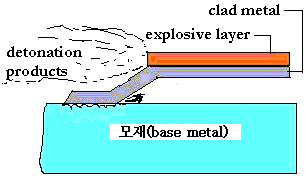|
폭발용접(爆發熔接; explosive welding)
|

|
|
Explosive welding is a solid state welding process, which uses a controlled explosive detonation to
force two metals together at high pressure. The resultant composite system is joined with a durable,
metallurgical bond. This is a solid state joining process. When an explosive is detonated on the surface of a metal, a high pressure pulse is generated. This pulse propels the metal at a very high rate of speed. If this piece of metal collides at an angle with another piece of metal, welding may occur. For welding to occur, a jetting action is required at the collision interface. This jet is the product of the surfaces of the two pieces of metals colliding. This cleans the metals and allows to pure metallic surfaces to join under extremely high pressure. The metals do not commingle, they are atomically bonded. Due to this fact, any metal may be welded to any metal (i.e.- copper to steel; titanium to stainless). Typical impact pressures are millions of psi. Fig. 1 shows the explosive welding process.
|